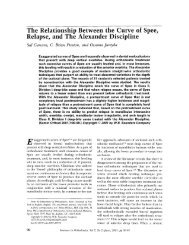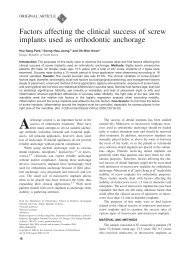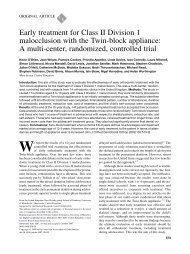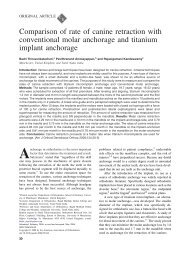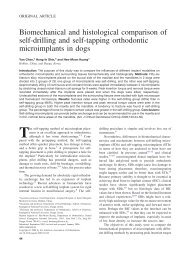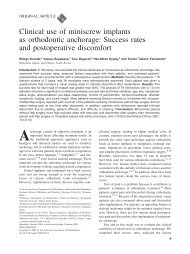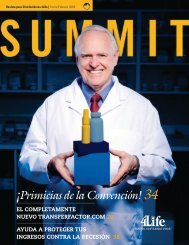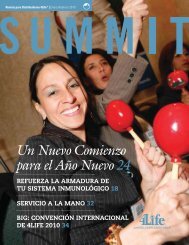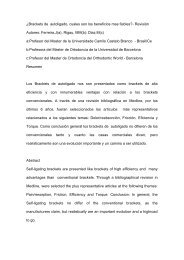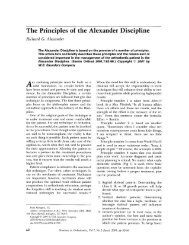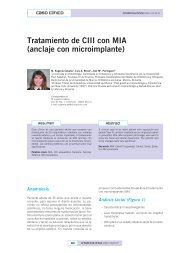Leveling the curve of Spee with a continuous archwire technique: A ...
Leveling the curve of Spee with a continuous archwire technique: A ...
Leveling the curve of Spee with a continuous archwire technique: A ...
You also want an ePaper? Increase the reach of your titles
YUMPU automatically turns print PDFs into web optimized ePapers that Google loves.
368 Bernstein, Preston, and Lampasso<br />
After treatment, <strong>the</strong> incisors retroclined a mean distance<br />
<strong>of</strong> –0.10 mm relative to <strong>the</strong> A-Po line, resulting<br />
in an overall (T3) mean proclination <strong>of</strong> 1.41 mm<br />
(SD, 1.57 mm). A negative value for <strong>the</strong> measurement<br />
represents lingual movement <strong>of</strong> <strong>the</strong> tip <strong>of</strong> <strong>the</strong> tooth.<br />
There was a statistically significant difference between<br />
<strong>the</strong> T1 and T2 measurements P ( .0001) (Table IV).<br />
American Journal <strong>of</strong> Orthodontics and Dent<strong>of</strong>acial Orthopedics<br />
March 2007<br />
leveled completely, whereas 32% had slight residual<br />
COS at T2. For <strong>the</strong> latter patients, <strong>the</strong> average amount<br />
<strong>of</strong> COS at T2 was 0.19 mm; this is probably clinically<br />
insignificant. The T2 models all showed Class I molar<br />
and canine relationships <strong>with</strong> properly finished buccal<br />
DISCUSSION<br />
It is generally accepted that, <strong>with</strong> a few notable<br />
exceptions, leveling a deep COS makes an important<br />
contribution to <strong>the</strong> success <strong>of</strong> orthodontic treatment.<br />
18-20,34,39-43 In a study that compared sectional<br />
and <strong>continuous</strong> <strong>archwire</strong> treatments <strong>of</strong> adolescent patients<br />
<strong>with</strong> Class II, deep-bite, low-angle malocclusions,<br />
it was found that both <strong>technique</strong>s corrected deep<br />
bites. 4,5 Although <strong>the</strong>se studies compared <strong>the</strong> effective -<br />
ness <strong>of</strong> overbite correction as measured on cephalometric<br />
x-rays, <strong>the</strong>y did not measure <strong>the</strong> COS, or <strong>the</strong><br />
effectiveness and long-term stability <strong>of</strong> leveling <strong>the</strong><br />
COS. Our study was prompted by a belief that <strong>the</strong>re<br />
was a need for a long-term, comprehensive, radiographic,<br />
and study model analysis <strong>of</strong> <strong>the</strong> effectiveness<br />
and stability <strong>of</strong> leveling <strong>the</strong> COS.<br />
Before we analyzed <strong>the</strong> data from <strong>the</strong> cephalometric<br />
investigation, <strong>the</strong> radiographic assessment <strong>of</strong> <strong>the</strong> COS<br />
performed in this investigation required validation.<br />
Integral to this process were <strong>the</strong> COS measurements<br />
21<br />
recorded by Carcara et al in <strong>the</strong>ir study model<br />
analysis <strong>of</strong> <strong>the</strong> COS in <strong>the</strong> same sample group. The 2<br />
sets <strong>of</strong> measurements were compared and analyzed to<br />
determine whe<strong>the</strong>r <strong>the</strong> method <strong>of</strong> recording <strong>the</strong> COS<br />
from lateral cephalographic x-rays produced <strong>the</strong> same<br />
results as those recorded from <strong>the</strong> study models. There<br />
were no statistically significant differences (P .01)<br />
between <strong>the</strong> radiographic and <strong>the</strong> study model COS<br />
measurements for any <strong>of</strong> <strong>the</strong> 31 patients at T1, T2, and<br />
T3. 21 occlusions and normal overjets and overbites.<br />
Results <strong>of</strong> <strong>the</strong> paired t test comparing <strong>the</strong> COS at T2<br />
<strong>with</strong> that at T3 indicated a statistically significant<br />
change (P .001) in this metrical character. The COS<br />
increased from a mean <strong>of</strong> 0.19 mm at T2 to a mean <strong>of</strong><br />
0.69 mm at T3. Thus, <strong>the</strong> COS relapsed on average 0.5<br />
0mm over a mean period <strong>of</strong> 7 years 5 months after <strong>the</strong><br />
fixed lingual canine-to-canine mandibular retainers<br />
were removed (an average <strong>of</strong> 11 years 5 months<br />
postdebond). Although <strong>the</strong> relapse in <strong>the</strong> COS might be<br />
statistically significant, it is a relatively small change,<br />
which, in turn, probably represents a normal physiologic<br />
process.<br />
The correlation percentage between <strong>the</strong> 2 meth -<br />
ods was approximately 97%. Only 1 patient who was<br />
measured to be level after treatment in <strong>the</strong> study model<br />
analysis was not considered level in <strong>the</strong> cephalometric<br />
analysis. Taking into account all factors that could have<br />
influenced <strong>the</strong> recordings <strong>of</strong> <strong>the</strong> COS by <strong>the</strong> 2 methods<br />
and <strong>the</strong> closeness <strong>of</strong> <strong>the</strong> results, we believe that <strong>the</strong><br />
proposed radiographic assessment <strong>of</strong> <strong>the</strong> COS is valid.<br />
The cephalometric radiographs were taken on a Quint<br />
Sectograph that was set to focus on <strong>the</strong> cranial landmarks<br />
on <strong>the</strong> left side <strong>of</strong> <strong>the</strong> face.<br />
From this study, it seems that <strong>the</strong> <strong>continuous</strong><br />
<strong>archwire</strong> <strong>technique</strong> is an effective orthodontic approach<br />
for leveling a COS in Class II Division 1 nonextraction<br />
deep-bite patients whose initial COS was 2 to 4 mm.<br />
Sixty-eight percent <strong>of</strong> <strong>the</strong> patients studied here were<br />
19-21,27 A previous study, although con -<br />
firming that <strong>the</strong> leveling <strong>of</strong> <strong>the</strong> COS is a stable<br />
treatment outcome, could not show that <strong>the</strong> amount <strong>of</strong><br />
leveling was correlated <strong>with</strong> <strong>the</strong> amount <strong>of</strong> relapse <strong>of</strong><br />
this parameter. 44 Unfortunately, those authors did not<br />
specify <strong>the</strong> treatment <strong>technique</strong> used to treat <strong>the</strong>ir<br />
patients, who had various malocclusion types. In our<br />
study, <strong>the</strong> COS tended to relapse more in subjects <strong>with</strong><br />
<strong>the</strong> deepest COS at T1. The Pearson correlation coefficient<br />
(initial COS vs posttreatment changes) was<br />
0.380 (P .0349); this was statistically significant <strong>with</strong><br />
set at 0.05 but not <strong>with</strong> set at 0.01. At least 1 o<strong>the</strong>r<br />
study confirmed our finding that <strong>the</strong> more <strong>the</strong> COS is<br />
leveled during treatment, <strong>the</strong> more it relapses after<br />
treatment. 45 That study had a relatively short mean<br />
posttreatment time <strong>of</strong> 2 years 8 months in <strong>the</strong>ir patients,<br />
who were treated <strong>with</strong> various appliances, and who had<br />
different malocclusion types. Although dental heights<br />
were recorded in <strong>the</strong> study <strong>of</strong> mixed malocclusions, no<br />
attempt was made to compensate for <strong>the</strong> affects <strong>of</strong><br />
growth on <strong>the</strong>se dimensions.<br />
The overall long-term (T3-T1) effect <strong>of</strong> orthodontic<br />
treatment <strong>with</strong> <strong>the</strong> <strong>continuous</strong> arch <strong>technique</strong> was an<br />
average <strong>of</strong> 72.97% reduction in <strong>the</strong> pretreatment COS.<br />
Ten <strong>of</strong> <strong>the</strong> 31 patients remained 100% level over a time<br />
span <strong>of</strong> 5 to 25 years after orthodontic treatment. Only<br />
5 patients had residual COS <strong>of</strong> over 1 mm, and none<br />
was deeper than 2 mm. This study indicates that relapse<br />
in <strong>the</strong> COS occurred slowly and over an extended<br />
period <strong>of</strong> time.<br />
Although <strong>the</strong>re are speculations in <strong>the</strong> literature<br />
about <strong>the</strong> contributions <strong>of</strong> various occlusal elements<br />
involved in leveling <strong>the</strong> COS, <strong>the</strong>se reports do not<br />
quantify <strong>the</strong> contributions.<br />
3,19,43-47 At <strong>the</strong> outset <strong>of</strong> this<br />
study, <strong>the</strong>re was an attempt to use a mandibular<br />
superimposition method, 48 patterned after Björk’s<br />
21



